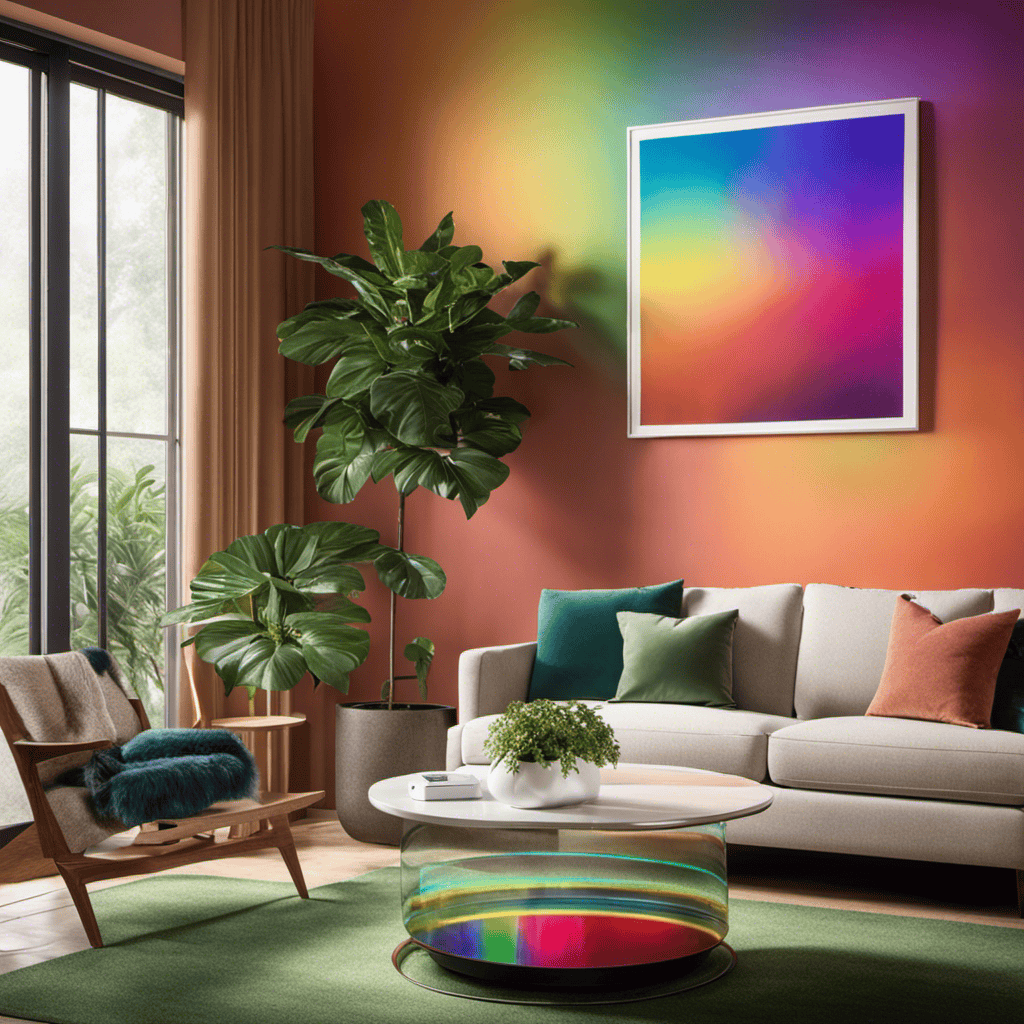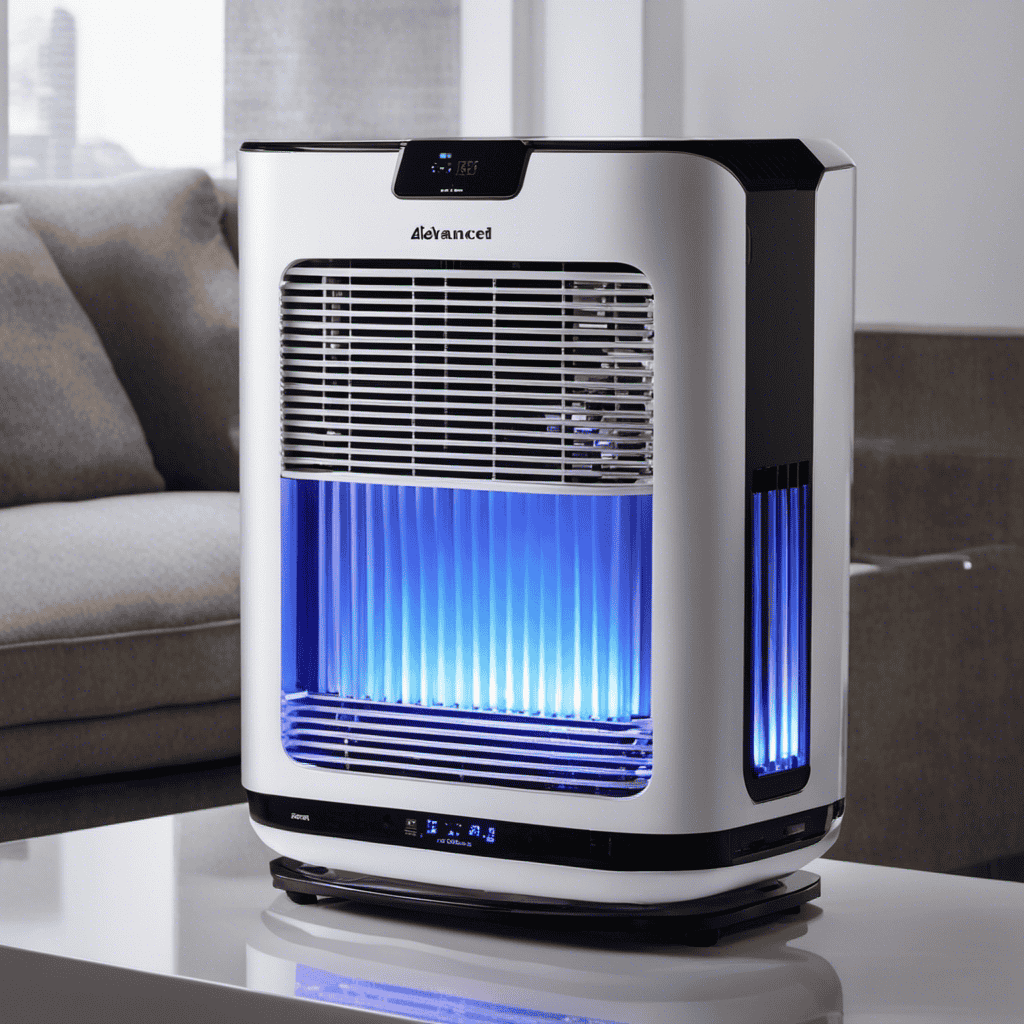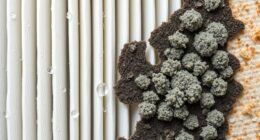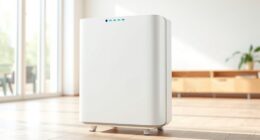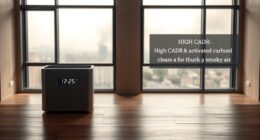Did you know that indoor air can be up to five times more polluted than outdoor air? Therefore, it’s essential to clean your **Germ Guardian Air Purifier** routinely to maintain the highest air quality in your home. Discover why regular maintenance is key to breathing in fresh, clean air every day!
In this article, I will guide you through the step-by-step process of cleaning your Germ Guardian Air Purifier, from the exterior to the filters and even the power cord. By following these simple instructions, you can maintain a healthier and cleaner environment for you and your family.
Key Takeaways
- Regular cleaning and filter replacement are crucial for maintaining the effectiveness of the Germ Guardian Air Purifier.
- Accumulated contaminants on filters can reduce their efficiency and release them back into the air, so it’s important to clean the filters regularly.
- Cleaning the exterior surfaces of the air purifier with a soft cloth and using a brush attachment to remove dust and debris from vents and grills can help maintain its performance.
- Regularly replacing filters every 6-12 months, using genuine Germ Guardian replacement filters, and cleaning the pre-filter to prevent debris buildup are important steps in maintaining the air purifier’s effectiveness.
Understanding the Importance of Cleaning Your Germ Guardian Air Purifier
Understanding the importance of cleaning your Germ Guardian air purifier is essential for maintaining its performance. Regular cleaning and filter replacement are crucial to ensure that your air purifier continues to function effectively and efficiently.
Over time, air purifiers accumulate common contaminants such as dust, pet dander, pollen, and bacteria. These contaminants can build up on the filters, reducing their effectiveness and potentially releasing them back into the air.
Cleaning your air purifier not only helps remove these contaminants but also extends the lifespan of the device. It is recommended to clean the outer casing of the air purifier with a soft, damp cloth and to replace the filters according to the manufacturer’s instructions.
Necessary Supplies for Cleaning Your Germ Guardian Air Purifier
When it comes to cleaning my Germ Guardian air purifier, there are a few key tools that I always make sure to have on hand.
First and foremost, I need a soft, lint-free cloth to gently wipe down the exterior surfaces of the purifier.
Additionally, a small brush with soft bristles is essential for removing any dust or debris that may have accumulated in the filters or vents.
Lastly, a mild cleaning solution diluted with water is necessary for a thorough and effective cleaning.
To ensure proper cleaning techniques, it is important to follow the manufacturer’s instructions and guidelines.
Cleaning Tools Needed
To clean your Germ Guardian air purifier, you’ll need a few tools. I recommend having the following supplies on hand to ensure a thorough and effective cleaning process.
| Tools | Description |
|---|---|
| Soft cloth | A soft cloth is essential for wiping down the exterior and interior of the air purifier. Avoid using abrasive materials that could scratch the surface. |
| Brush attachment | A brush attachment for your vacuum cleaner can help remove dust and debris from the air purifier’s filters and vents. Make sure the attachment is clean before using it to prevent cross-contamination. |
| Compressed air canister | This tool is useful for blowing out any stubborn dust or dirt that may be trapped in hard-to-reach areas of the air purifier. Be sure to follow the manufacturer’s instructions when using compressed air. |
Proper Cleaning Techniques
Using a soft cloth and a brush attachment for your vacuum cleaner are effective techniques for maintaining the cleanliness of your Germ Guardian air purifier. Here are some proper cleaning techniques and effective cleaning methods to ensure your purifier functions optimally:
- Gently wipe the external surfaces of the purifier with a soft cloth to remove any dust or dirt buildup.
- Use the brush attachment of your vacuum cleaner to remove larger particles from the air intake vents and grills.
- Clean the filters regularly according to the manufacturer’s instructions to maintain their efficiency.
- Consider using compressed air to blow away any stubborn debris from hard-to-reach areas.
By following these proper cleaning techniques, you can ensure that your Germ Guardian air purifier remains in top-notch condition and provides you with clean and fresh air.
Now, let’s move on to the next section where we will provide a step-by-step guide to cleaning the exterior of your Germ Guardian air purifier.
Step-by-Step Guide to Cleaning the Exterior of Your Germ Guardian Air Purifier
You’ll want to start by unplugging your Germ Guardian air purifier before proceeding with cleaning the exterior. To properly clean the exterior of your air purifier, you will need a few necessary supplies. These include a microfiber cloth, mild detergent, and warm water.
Here is a step-by-step guide on how to clean the exterior of your Germ Guardian air purifier:
- Mix a small amount of mild detergent with warm water.
- Dampen the microfiber cloth with the soapy water solution.
- Gently wipe the exterior surfaces of the air purifier, being careful not to get any water into the unit.
- Pay extra attention to areas that accumulate dust and dirt, such as the control panel and vents.
- Rinse the cloth with clean water and wring out excess moisture before continuing.
- Wipe down the exterior again with the damp cloth to remove any soap residue.
- Dry the air purifier thoroughly with a clean, dry microfiber cloth.
How to Safely Remove and Clean the Germ Guardian Air Purifier Filters
Proper filter maintenance is crucial for ensuring the optimal performance of your Germ Guardian Air Purifier. In this discussion, we will explore the best cleaning techniques for filters and the frequency at which they should be cleaned.
Proper Filter Maintenance
To ensure your Germ Guardian air purifier functions efficiently, it’s important to regularly maintain its filters. Proper filter replacement and addressing common filter problems are key to keeping your air purifier working effectively. Here are four important things to consider when it comes to filter maintenance:
-
Regular replacement: Filters should be replaced every 6-12 months, depending on usage and air quality. This ensures optimal performance and prevents clogging.
-
Genuine filters: Always use genuine Germ Guardian replacement filters. Generic or counterfeit filters may not fit properly or provide the same level of filtration.
-
Filter lifespan indicators: Many Germ Guardian models have built-in indicators that notify you when it’s time to replace the filters. Pay attention to these indicators to maintain the purifier’s efficiency.
-
Clean the pre-filter: The pre-filter is the first line of defense against larger particles. Clean it regularly to prevent debris buildup and maintain the purifier’s overall effectiveness.
By following these proper filter maintenance practices, you can ensure your Germ Guardian air purifier continues to provide clean and fresh air.
Now let’s explore the cleaning techniques for filters to further enhance its performance.
Cleaning Techniques for Filters
Regularly maintaining the filters of your Germ Guardian air purifier is essential for optimal performance and clean air, and there are various cleaning techniques that can enhance their effectiveness. One effective technique is to vacuum the filters using a soft brush attachment to remove dust and debris. Another technique is to rinse the filters under running water to remove trapped particles. For deeper cleaning, you can soak the filters in a mixture of water and mild detergent, then rinse thoroughly and let them dry completely before reinstalling. It’s important to note that not all filters are washable, so be sure to check the manufacturer’s instructions.
Here is a table to illustrate the different cleaning techniques for Germ Guardian air purifier filters:
| Cleaning Technique | Description |
|---|---|
| Vacuuming | Use a soft brush attachment to remove dust and debris. |
| Rinsing | Rinse the filters under running water to remove trapped particles. |
| Soaking | Soak the filters in a mixture of water and mild detergent, then rinse and dry. |
| Dry Cleaning | Use a dry cloth or brush to remove surface dust and debris. |
| Replacement | Some filters cannot be cleaned and must be replaced. |
Frequency of Filter Cleaning
Make sure you’re aware of how often you should clean the filters of your air purifier to maintain its effectiveness. Cleaning the filters regularly is crucial for the proper functioning of your air purifier and to ensure that it continues to provide clean and fresh air. Here is a recommended cleaning schedule for your air purifier filters:
-
Pre-filter: Clean the pre-filter every 1-2 weeks. This filter captures large particles like dust and pet hair, preventing them from clogging the main filters.
-
True HEPA filter: Clean or replace the True HEPA filter every 6-12 months, depending on the air quality and usage. This filter captures 99.97% of airborne particles and needs regular maintenance to function optimally.
-
Carbon filter: Replace the carbon filter every 6 months. It helps remove odors and VOCs from the air.
-
UV-C light: Clean the UV-C light every 3-6 months by wiping it gently with a soft cloth.
Following this cleaning schedule and regular filter replacement will ensure that your air purifier continues to provide clean and healthy air for you and your family.
Now, let’s move on to the next section about tips for properly cleaning the germ guardian air purifier fan.
Tips for Properly Cleaning the Germ Guardian Air Purifier Fan
When cleaning your Germ Guardian Air Purifier fan, remember to unplug it first to avoid any potential electrical hazards.
Cleaning the fan of your air purifier is an essential maintenance task that ensures optimal performance and prolongs the lifespan of the appliance.
To clean the fan, start by removing the front grille and gently wiping it with a damp cloth.
Use a soft brush or compressed air to remove dust and debris from the fan blades.
If the fan is excessively dirty, you can also wash the grille in warm, soapy water and let it air dry before reattaching it.
Remember to refer to the user manual for specific cleaning instructions and troubleshooting tips to ensure your Germ Guardian Air Purifier fan continues to function effectively.
These cleaning hacks will help keep your air purifier fan running smoothly and efficiently.
Cleaning the Germ Guardian Air Purifier Control Panel and Buttons
After unplugging the device, gently wipe the control panel and buttons of your Germ Guardian air purifier with a damp cloth. Cleaning the control panel is essential for maintaining the Germ Guardian air purifier’s performance.
Here are four important steps to follow:
-
Use a soft, lint-free cloth: This will prevent any scratches or damage to the control panel.
-
Dampen the cloth: Make sure the cloth is only slightly damp to avoid any water damage. Avoid using excessive moisture.
-
Wipe the control panel and buttons: Gently wipe the control panel and buttons in a circular motion. This will remove any dirt, dust, or fingerprints.
-
Dry the control panel: After wiping, use a dry cloth to remove any remaining moisture. This will prevent any water from entering the internal components.
Removing and Cleaning the Germ Guardian Air Purifier UV-C Bulb
To remove and clean the UV-C bulb in your Germ Guardian air purifier, first, ensure the device is unplugged. Then, gently twist the bulb counterclockwise to remove it from the unit.
Cleaning the Germ Guardian air purifier’s exterior is an important step in maintaining the device’s performance. Start by wiping the exterior with a soft, damp cloth to remove any dust or dirt. Avoid using harsh chemicals or abrasive materials that could damage the surface.
Pay special attention to the vents and filters, as these areas can accumulate debris over time. Regularly cleaning the exterior of your Germ Guardian air purifier will help to ensure optimal airflow and prevent any buildup that could hinder its performance.
How to Clean the Germ Guardian Air Purifier Pre-Filter
Now that we’ve learned how to remove and clean the Germ Guardian Air Purifier UV-C bulb, let’s move on to the next step in maintaining the air purifier – cleaning the pre-filter.
The pre-filter plays a crucial role in capturing larger particles like dust, pet hair, and lint, preventing them from clogging the main HEPA filter. To ensure optimal performance and longevity of your Germ Guardian Air Purifier, regular pre-filter maintenance is essential.
Here are some troubleshooting tips for pre-filter issues:
-
Check for dirt and debris: Inspect the pre-filter for any visible dirt or debris. Gently tap it against a hard surface to remove loose particles.
-
Vacuuming: Use a vacuum cleaner with a brush attachment to remove any accumulated dust or dirt from the pre-filter.
-
Washing: If the pre-filter is washable, gently rinse it under running water. Avoid using harsh chemicals or scrubbing aggressively, as this may damage the filter.
-
Drying: Allow the pre-filter to air dry completely before reinstalling it in the air purifier.
Cleaning the Germ Guardian Air Purifier Ionizer Plates
When it comes to cleaning the ionizer plates on the Germ Guardian Air Purifier, there are several key points to consider.
First, it is important to understand the proper plate cleaning techniques to ensure optimal performance and longevity of the device.
Additionally, knowing the frequency at which the plates should be cleaned can help maintain a healthy environment and prevent the buildup of contaminants.
Proper Plate Cleaning
It’s important to regularly clean the plates in your Germ Guardian air purifier. The plates play a crucial role in capturing and removing airborne contaminants, so keeping them clean ensures optimal performance.
Here are four key tips for proper plate cleaning:
-
Plate Cleaning Frequency: Clean the plates at least once every two weeks. However, if you live in an area with high pollution levels or have pets, more frequent cleaning may be necessary.
-
Best Cleaning Products for Plates: Use a mild dish soap or a specially formulated air purifier cleaning solution. Avoid using harsh chemicals or abrasive cleaners, as these can damage the plates.
-
Cleaning Process: Remove the plates from the air purifier and gently wash them with warm water and the chosen cleaning solution. Use a soft brush or sponge to remove any stubborn dirt or residue.
-
Drying and Reinstallation: Thoroughly dry the plates before reinstalling them into the air purifier. Ensure they are completely dry to prevent mold or bacterial growth.
Frequency of Plate Cleaning
To ensure optimal performance, make sure you clean the plates in your air purifier at least once every two weeks. Proper plate maintenance is crucial for the effectiveness of your air purifier in removing airborne pollutants and improving indoor air quality.
Over time, dust, dirt, and other particles can accumulate on the plates, reducing their efficiency. Cleaning the plates regularly helps to maintain their electrostatic charge and ensures that they can effectively capture and trap pollutants.
When cleaning the plates, it is important to use effective plate cleaning techniques. This includes gently removing the plates from the air purifier, using a soft brush or cloth to wipe away any visible debris, and then rinsing them with water or a mild detergent solution. Allow the plates to dry completely before reinserting them into the air purifier.
Plate Cleaning Techniques
Regularly cleaning the plates is essential for maintaining the effectiveness of your air purifier. Neglecting proper plate maintenance can lead to reduced air purification performance and even potential damage to the device.
To ensure optimal performance and longevity of your air purifier, follow these effective plate cleaning techniques:
-
Remove the plates: Start by turning off the device and unplugging it. Carefully remove the plates from the purifier according to the manufacturer’s instructions.
-
Gentle cleaning: Use a soft brush or cloth to gently remove any visible dirt, dust, or debris from the plates. Avoid using harsh chemicals or abrasive materials that could damage the plates.
-
Rinse with water: After removing loose particles, rinse the plates under running water. Ensure the water pressure is not too high to prevent bending or damaging the delicate plates.
-
Air dry and reassemble: Allow the plates to air dry completely before reassembling them back into the air purifier. Once dry, carefully insert the plates back into their designated slots, ensuring proper alignment.
Maintaining the Germ Guardian Air Purifier’s Air Quality Sensor
Check if the air quality sensor on your Germ Guardian Air Purifier is clean and unobstructed. Cleaning the Germ Guardian Air Purifier’s vents is essential to maintain the efficiency of the air quality sensor.
Over time, dust and debris can accumulate on the sensor, affecting its performance. To clean the sensor, first, ensure the purifier is turned off and unplugged. Gently remove the front panel and locate the air quality sensor. Use a soft, dry cloth to wipe away any dirt or dust particles. Avoid using water or cleaning agents as they may damage the sensor.
If the air quality sensor is still not functioning properly, consult the user manual for troubleshooting tips or contact customer support.
Now, let’s move on to learning how to clean the Germ Guardian Air Purifier’s water tank (if applicable).
How to Clean the Germ Guardian Air Purifier’s Water Tank (If Applicable
Regular maintenance of the water tank in your Germ Guardian Air Purifier is essential for optimal performance and longevity. To ensure clean and healthy air, it’s recommended to clean the water tank every two weeks or as needed, depending on the level of usage.
Water Tank Maintenance Tips
To keep your Germ Guardian air purifier running smoothly, make sure to clean the water tank regularly.
The frequency of water tank cleaning will depend on the usage and the quality of the water in your area. However, as a general guideline, it is recommended to clean the water tank every 1-2 weeks. This will help prevent the accumulation of dirt, bacteria, and mold, ensuring that your air purifier continues to provide clean and fresh air.
When cleaning the water tank, it is important to use the best cleaning products for water tank maintenance. Look for non-toxic and gentle cleaners that are specifically designed for cleaning humidifier tanks. Avoid using harsh chemicals or bleach, as they can damage the tank and potentially release harmful fumes into the air.
Cleaning Frequency Recommendations
Cleaning the water tank every 1-2 weeks helps prevent the accumulation of dirt, bacteria, and mold. Regular maintenance is crucial to ensure the optimal performance and longevity of your water tank.
By adhering to a consistent cleaning schedule, you can maintain clean and safe water for your household. It is recommended to clean the water tank every 1-2 weeks, depending on the usage and water quality. This frequency allows you to remove any potential contaminants and maintain the tank’s overall cleanliness.
To clean the water tank, start by draining all the water and then scrubbing the interior with a mild detergent and a soft brush. Rinse thoroughly to remove any residue and allow the tank to dry completely before refilling. Additionally, regularly inspect the tank for any signs of damage or leaks to ensure proper functioning.
Following these cleaning frequency and maintenance tips will help keep your water tank in optimal condition and ensure the continuous supply of clean water.
Cleaning the Germ Guardian Air Purifier’s Diffuser Tray (If Applicable
If you’re wondering how to clean the Germ Guardian Air Purifier’s diffuser tray, it’s important to follow these steps:
-
Turn off and unplug the air purifier before cleaning to ensure safety.
-
Carefully remove the diffuser tray from the air purifier unit.
-
Gently wash the diffuser tray with warm, soapy water. Use a soft cloth or sponge to remove any dirt or debris. Avoid using abrasive cleaners or scrub brushes that could damage the tray.
-
Rinse the tray thoroughly with clean water to remove any soap residue.
By regularly cleaning the Germ Guardian Air Purifier’s diffuser tray, you can ensure that it continues to function effectively and efficiently.
Once you have cleaned the diffuser tray, you can move on to the next step of removing and cleaning the Germ Guardian Air Purifier’s aromatherapy pad (if applicable).
Removing and Cleaning the Germ Guardian Air Purifier’s Aromatherapy Pad (If Applicable
Once you’ve unplugged the unit, carefully remove and clean the aromatherapy pad in the Germ Guardian Air Purifier (if applicable). Cleaning the aromatherapy pad is an essential part of maintaining the air purifier’s effectiveness and ensuring that it continues to provide you with clean and fresh air.
To clean the pad, start by gently removing it from the unit. Then, rinse it under warm water to remove any dirt or debris. You can also use a mild dish soap to help remove any stubborn stains or odors. After rinsing, allow the pad to air dry completely before reinserting it into the unit.
It is recommended to clean the aromatherapy pad every 1-2 months, or more frequently if necessary, to maintain optimal performance and prolong the lifespan of your Germ Guardian Air Purifier.
How to Clean the Germ Guardian Air Purifier’s Power Cord and Plug
When maintaining your Germ Guardian Air Purifier, it’s important to regularly check and clean the power cord and plug to ensure proper functioning and longevity. Here are some tips on how to clean the power cord and plug effectively:
-
Disconnect the air purifier from the power source before cleaning to avoid any electrical accidents.
-
Use a dry cloth to wipe the power cord and plug gently. Avoid using water or cleaning agents as they can damage the electrical components.
-
Inspect the cord for any signs of damage such as fraying or exposed wires. If you notice any issues, it’s best to replace the cord to prevent potential hazards.
-
To organize your cleaning supplies, consider using storage bins or caddies to keep everything in one place. Label each container for easy identification and access.
Is the Cleaning Process Similar for Different Brands of Air Purifiers?
When it comes to the cleaning process, each brand of air purifier may have its own specific requirements. However, for the clean edenpure air purifier, the process generally involves regular filter replacements and occasional exterior cleaning to ensure optimal performance and air quality in your home.
Tips for Regular Maintenance and Cleaning of Your Germ Guardian Air Purifier
To ensure optimal performance and longevity of your Germ Guardian Air Purifier, it’s important to regularly maintain and clean various components.
One crucial aspect of maintenance is filter replacement. Filters should be replaced every 6-8 months, depending on usage and air quality. This ensures that the purifier continues to effectively remove airborne contaminants.
When replacing the filter, make sure to turn off the unit and unplug it from the power source. Gently remove the old filter and dispose of it properly. Insert the new filter, following the manufacturer’s instructions, and secure it in place.
Additionally, it’s essential to troubleshoot common issues that may arise. If the unit is not turning on, check the power cord and plug for any damage. If there are any signs of wear or fraying, replace the cord immediately.
Regular maintenance and troubleshooting will keep your Germ Guardian Air Purifier running smoothly and efficiently.
Frequently Asked Questions
How Often Should I Clean My Germ Guardian Air Purifier?
I clean my Germ Guardian air purifier once every 3 months. It’s important to replace the filters regularly as well. Alternative cleaning methods include wiping the exterior with a damp cloth and using a vacuum attachment to remove dust from the vents.
Can I Use Regular Household Cleaning Products to Clean My Germ Guardian Air Purifier?
Sure, you can use regular household cleaning products to clean your Germ Guardian air purifier. However, it is recommended to use the manufacturer’s recommended cleaning products for optimal performance and to avoid any potential damage.
Is It Necessary to Clean the Germ Guardian Air Purifier’s Water Tank if I Don’t Use the Humidifier Function?
It is important to clean the Germ Guardian air purifier’s water tank regularly, regardless of whether the humidifier function is used. Cleaning frequency and techniques are crucial to maintain optimal performance and prevent the buildup of bacteria and mold.
How Do I Know When It’s Time to Replace the Germ Guardian Air Purifier Filters?
When to replace Germ Guardian filters depends on signs of dirtiness. Typically, it’s recommended to replace them every 6-8 months. Signs of dirty filters include reduced airflow and a decrease in the purifier’s effectiveness.
Are There Any Specific Safety Precautions I Need to Take When Cleaning the Germ Guardian Air Purifier’s UV-C Bulb?
When cleaning the Germ Guardian Air Purifier’s UV-C bulb, it is important to take safety precautions. Follow the cleaning guidelines provided by the manufacturer and clean it regularly according to the recommended cleaning frequency.
Are the Cleaning Methods for Germ Guardian and Dyson Air Purifiers Similar?
Yes, the cleaning methods for Germ Guardian and Dyson air purifiers are similar. When cleaning my Dyson air purifier, I simply need to follow the manufacturer’s instructions for removing and cleaning the filters, wiping down the exterior, and ensuring proper maintenance for optimal performance.
Conclusion
In conclusion, properly cleaning your Germ Guardian Air Purifier is crucial for maintaining its effectiveness in purifying the air in your home. Neglecting regular cleaning can lead to a buildup of dust, allergens, and bacteria, which can diminish its performance.
Did you know that a study conducted by the Environmental Protection Agency found that indoor air can be up to five times more polluted than outdoor air? This statistic highlights the importance of using and maintaining an air purifier, like the Germ Guardian, to ensure cleaner and healthier air for you and your family.




